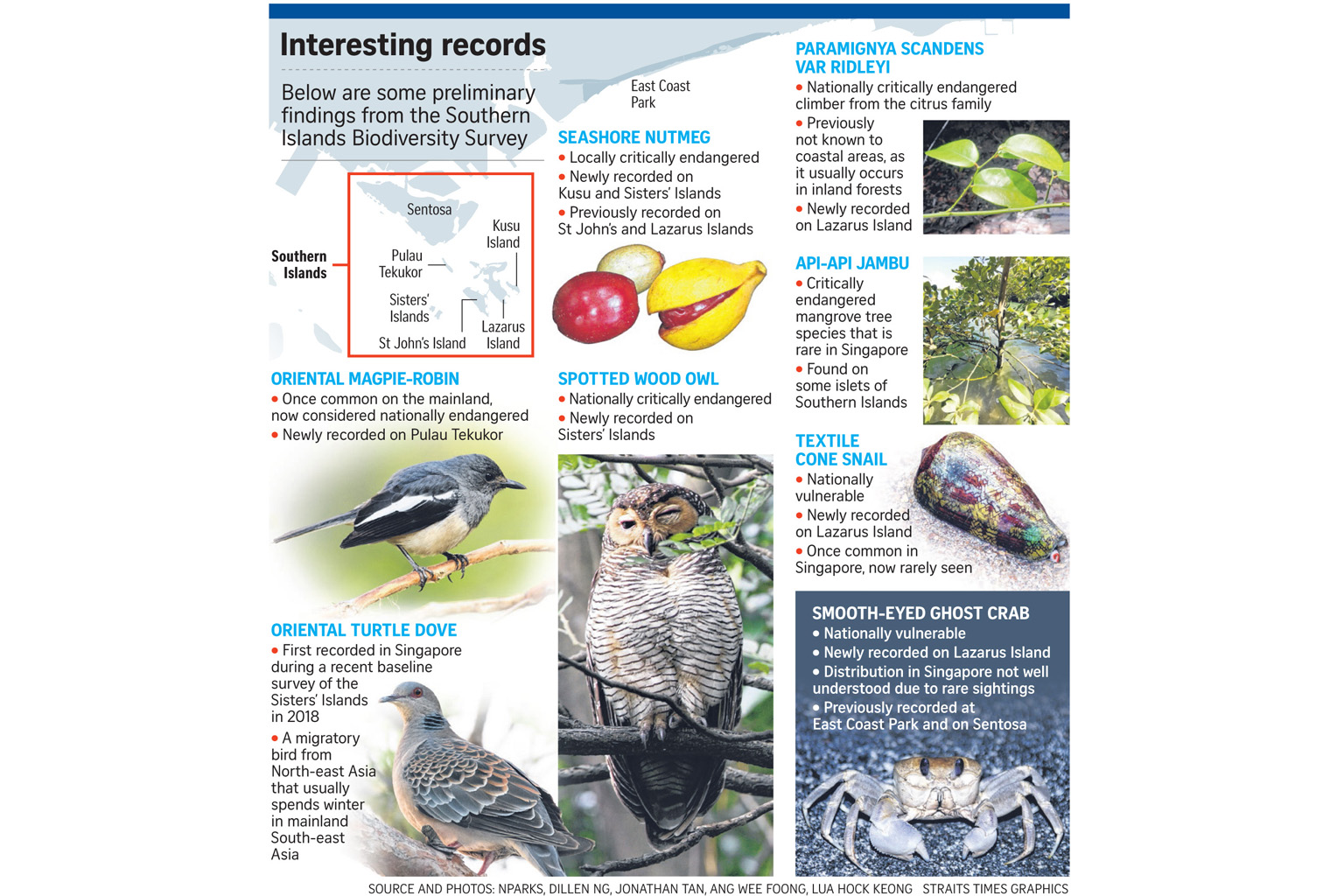Several rare species found in survey on Southern Islands
Early findings show they support rich habitats with endangered species unknown to area
Sign up now: Get ST's newsletters delivered to your inbox

Interesting records.
Calvin Yang
Follow topic:
A comprehensive biodiversity survey on the Southern Islands has discovered several rare and endangered species there, including the oriental magpie-robin and spotted wood owl.
The Southern Islands Biodiversity Survey looks at the terrestrial and marine habitats of over 10 islands south of mainland Singapore.
Preliminary findings show that while some of these islands are small and have a history of human activities, they are still able to support rich coastal habitats that contain rare and endangered species previously unknown to the area.
These habitats range from coastal forests and mangroves, to intertidal flats, subtidal reefs and shallow seafloor areas.
The National Parks Board (NParks) and the Friends of Marine Park community gave this update yesterday at the halfway mark of the two-year study, which covers the islands that make up Sisters' Islands Marine Park, well known islands such as Sentosa and Pulau Semakau, as well as smaller and lesser-known islands such as Pulau Biola and Pulau Jong. Some of the islands, such as Pulau Salu and Keppel Island, have never been surveyed before.
The islands in Sisters' Islands Marine Park and St John's Island cluster, for instance, range from about 2.7ha to 75.1ha in size - the equivalent of about three to 75 football fields.
The survey, which incorporates data from baseline studies carried out by NParks in recent years, began in January to understand the distribution of plants and animals and better guide conservation efforts.
Some of the nationally endangered species found there include the oriental magpie-robin, which was newly recorded on Pulau Tekukor, and the spotted wood owl, which was recorded on the Sisters' Islands.
The nationally vulnerable textile cone snail, which is highly venomous, was newly recorded on Lazarus Island this year.
A number of nationally critically endangered plant species were also newly recorded on various islands within the St John's-Sisters' Islands cluster.
Some coastal plants are now rare or extinct on the mainland. For example, the locally critically endangered seashore nutmeg was newly recorded on Kusu and Sisters' Islands. It can also be found on St John's and Lazarus Islands, as well as Pulau Ubin and Pulau Tekong.
Dr Karenne Tun, director of the coastal and marine division at NParks' National Biodiversity Centre, said studies like the Southern Islands Biodiversity Survey go towards ensuring future generations can continue to enjoy and appreciate Singapore's rich biodiversity.
Going forward, NParks will be deploying a remotely operated vehicle for seafloor surveys within areas of biodiversity interests at depths of 20m to 50m.
It will collect data via visual and acoustic mapping of the seabed through the use of side-scan and multi-beam sonars, together with photo and video footage. These surveys will add on to existing data that was collected during the Comprehensive Marine Biodiversity Survey in 2010 to 2015.
In addition, new records are being made for sea turtles.
In a pilot earlier this year, NParks attached satellite trackers to the carapaces of two hawksbill turtles that came ashore. Based on the signals recorded, the turtles swam along the eastern shores of Singapore before journeying to Riau in Indonesia, and are currently in their feeding grounds off Batam.
This is the first time such data is being recorded here, enabling researchers to better understand the travel patterns of nesting turtles. NParks will install more of such trackers on nesting turtles during the next nesting season.
Noting that the turtles visit Singapore more frequently than previously thought, Dr Tun said: "That would give us a better understanding of the turtles' movement, and also help us in the conservation of this particular species."

